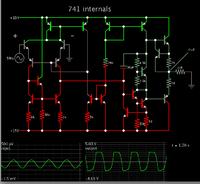ownway
Newbie level 4
I think it should be something elementary, however I really could not understand this:
I build up one example circuit just like below in Pspice 16(pls click to enlarge)

I know how op-amp works and how to calculate the gains. Normally I choose the R3=100k, R4=10k. In order to make my doubt more clear to you, I set R3=100, R4=10. And I choose a power op-amp LM675 instead of LM741. So the output gain is around 1+100/10=11. As you can see from the notation on the schematics, the input is 1V, and the output is 11V. So the simulation works.
But what I do not understand is that current goes in/out that op-amp. If you sum up the values of the current flowing through the 5 pins of LM675, the result is not 0! How could our simulation tool be against simple KCL? I don't understand. I know KCL will not work if you only take input and output pins into account(PIN1,2,4), but KCL should always work if you also consider the current from the voltage reference terminal(PIN3,5). Also as we already know, PIN4 as an output has a high voltage with high current, and this big current is supposed to be majorly contributed by the reference terminal PIN5. But the simulation shows that the current of PIN5 is much less than PIN4. You can also build up a circuit with different components in your own simulation tool, should be the similar result like me. Could anybody explain this to me? Thank you so much.
I build up one example circuit just like below in Pspice 16(pls click to enlarge)

I know how op-amp works and how to calculate the gains. Normally I choose the R3=100k, R4=10k. In order to make my doubt more clear to you, I set R3=100, R4=10. And I choose a power op-amp LM675 instead of LM741. So the output gain is around 1+100/10=11. As you can see from the notation on the schematics, the input is 1V, and the output is 11V. So the simulation works.
But what I do not understand is that current goes in/out that op-amp. If you sum up the values of the current flowing through the 5 pins of LM675, the result is not 0! How could our simulation tool be against simple KCL? I don't understand. I know KCL will not work if you only take input and output pins into account(PIN1,2,4), but KCL should always work if you also consider the current from the voltage reference terminal(PIN3,5). Also as we already know, PIN4 as an output has a high voltage with high current, and this big current is supposed to be majorly contributed by the reference terminal PIN5. But the simulation shows that the current of PIN5 is much less than PIN4. You can also build up a circuit with different components in your own simulation tool, should be the similar result like me. Could anybody explain this to me? Thank you so much.

